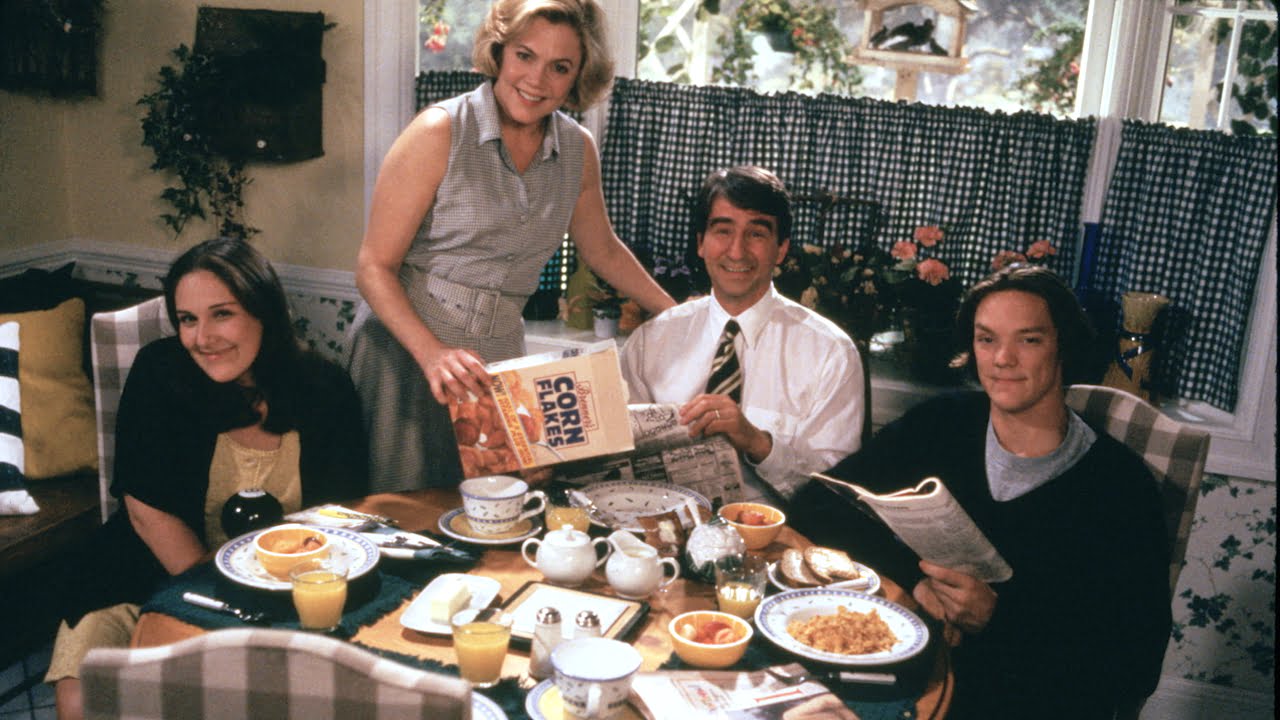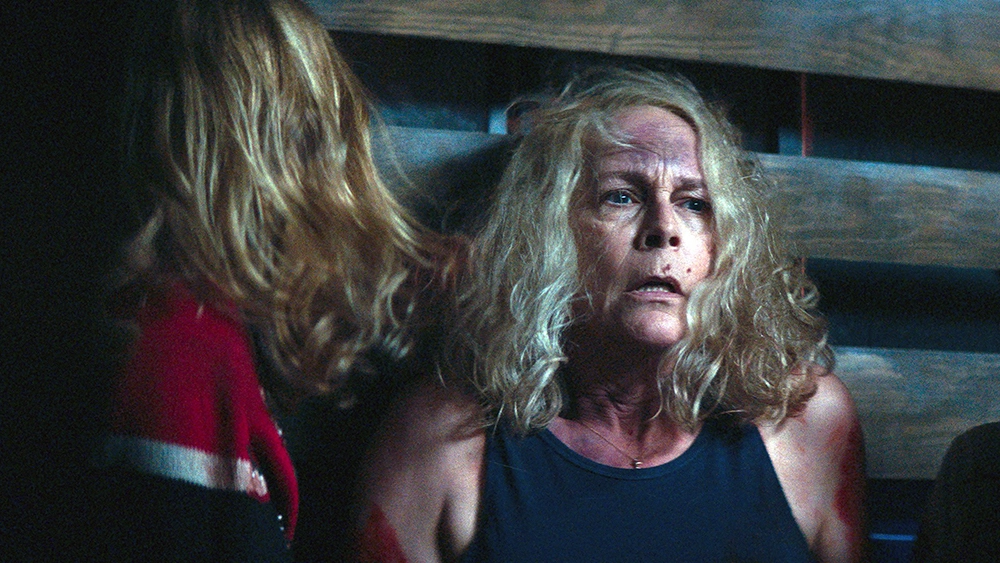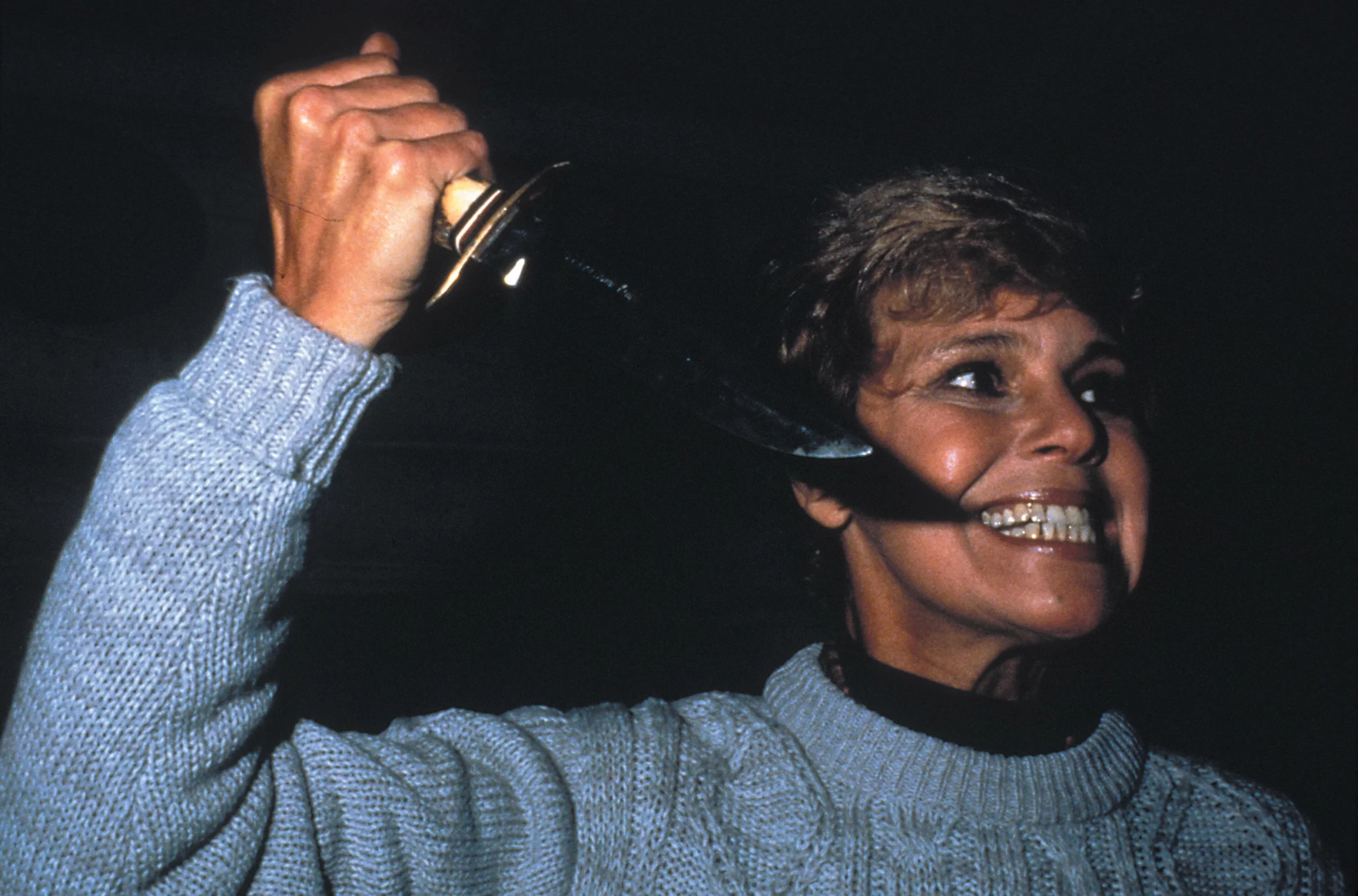Editorials
MATRONS OF THE MACABRE, UNITE! Who Is the Best Horror Movie Mom According to The Fans (And Why)?
Check out our ranking of the best mothers in horror movies. From The Shining to Nightmare on Elm Street we’ve ranked them all (mostly).

We decided to be charitable and give you these results early so you can discuss them with your own moms on Sunday. Just don’t fight her on who should be in the number one spot at brunch; let’s keep it classy.

5. Barbara, Shaun of the Dead
This fifth-place spot was a toughy since it’s shared with Rachel Keller from The Ring series. While Rachel tries her best against the ghostly tortures of Samara Morgan, Barbara was simply the obvious pick because…I mean, come on, she’s so sweet! She wouldn’t hurt a fly, let alone the pajama-clad zombie that bit her! Punctuating her tragic demise by thanking her son for being by her side, made watching such a wonderful movie mom pass away just a little bit more painful and infinitely more memorable.

4. Laurie Strode, Halloween Series
At the bottom of our top five list resides a horror movie legend who sparked a conversation between us here at Horror Press over what it means to be a good mother in the face of pure evil. Does the bad of spending your life preparing against your immortal nemesis and instilling fear in your child get canceled out by the good of protecting them? Despite her icon status, Laurie’s troubled past makes her undoubted love for her daughter and granddaughter come out in a strange and bloody way.

3.Pamela Voorhees, Friday the 13th
If we’re talking ride or die moms? Pamela is not the one to play with here, and the weird jump in votes shows that. Not only is she the first of the Friday series’ killers and, by extension, an icon of the genre, but she’s also kind of killing for a good reason?
Obviously, not every Camp Crystal Lake Counselor is culpable for bullying done by a bunch of prepubescents. Still, it’s very clear throughout the series that the campgrounds are somehow magnetized to attract jerks. Everything she does is an extension of her grieving for her son; in a way, she’s the most tragic mother figure on this list, and its clear that voters celebrate her for it.

2. Heather Langenkamp/Nancy Thompson, New Nightmare
The star of Wes Craven’s weird and highly underrated meta-fiction movie garnered a surprising number of votes, given the resident Freddy destroyer found herself at the bottom of the last list. Call it a comeback, I guess. Playing a fictionalized version of herself that’s fused with her Elm Street character’s legacy; this is the film where Heather kind of does the most and gets kicked into mama bear overdrive trying to save her son Dylan. Running across a highway, getting hit by a Pontiac, and straight-up fist fighting Freddy hand to hand in his demon lair. While she personally isn’t my pick, I fully understand why the ferocity she’s fighting with has landed her in your corner, dear voter.


1. Wendy Torrance from The Shining…& Chris McNeil from The Exorcist
But these two? These two are fully my pick.
It feels like a bit of a no-brainer that these two would reach the #1 spot in a tie, especially given their similarities. Both are women with huge hearts, thrust into situations where spectral beings haunt them. One may be ghosts and the other an ancient demon, but toma-toe tomat-o, potato Pazuzu, it’s all relative.
What matters most is their responses and drive to fight for Danny and Regan bely an intense love for their son and daughter. Whether it’s pea soup vomit and inventively crude expletives, or deranged husbands spurred by hotel-bound phantoms, the unreal performances of both Shelley Duvall and Sharon Glass show off the resilience of a mother’s love and the lengths they’ll go to to keep their child safe.
See you for the next survey, horror fans!
Editorials
Is ‘Funny Games’ The Perfect ‘Scream’ Foil?

When I begin crafting my reviews, I do some quick background research on the film itself, but I avoid looking at what others have to say. The last thing I want is for my views to be swayed in any way by what others think or say about a film. It has been at least 13 years since I’ve seen the English-language shot-for-shot remake of Funny Games. And I didn’t remember much about it. After watching the original 1997 masterpiece just minutes ago, I quickly ran to my computer to start writing this. Whether or not I’m breaking new ground by saying this is up in the air, and I could even be very incorrect with this: Funny Games is the perfect foil to Scream, and the irreparable damage it has caused to the slasher subgenre.
The Family at the Center of this Film
Funny Games follows the upper-class family of Anna (Susanne Lothar), George (Ulrich Mühe), son Georgie (Stefan Clapczynski), and dog Rolfi (Rolfi?), who arrive at their lake house for a few weeks of undisturbed peace. Soon after their arrival, they’re met by Paul (Arno Frisch) and Peter (Frank Giering), two white-clad yuppies who seem just a bit off. Who will survive and who will die in this game that is less funny than the title suggests?
I’ve made this statement about Scream time and time again. Before I get into it too much, let’s take a quick step back to ward off the Ryan C. Showers-like people. I love Scream (as well as 2, 5, and 6). It created a new wave of filmmakers and singlehandedly brought the slasher subgenre back from the dead like a Resident Evil zombie. Like what Tarantino did to independent crime thrillers of the 2000s and 10s, Scream has done to slashers. Post-Scream, slashers felt the need to be overtly meta and as twisty as possible, even at the film’s own demise. There is nothing wrong with a slasher film attempting to be smart. The problem arises when filmmakers who can’t pull it off think they can.
Is Funny Games Anti-Horror or Anti-Slasher?
The barebones rumblings I’ve heard about Funny Games over the years are that writer/director Michael Haneke calls it anti-horror. I would posit that Funny Games unknowingly found itself as more of an anti-slasher rather than an anti-horror. (Hell, it could be both!) Scream would release to acclaim just one year before Haneke’s incredible creation, so I can’t definitively say that Funny Games is a direct response to Scream, as much as I would like to.
Meta-ness has existed in cinema and art long before Scream came to be. Though if you had asked me when I was a freshman in high school, I would have told you Wes Craven created the idea of being meta. It just strikes me as a bit odd that two incredibly meta horror films would be released just one year apart and have such an impact on the genre. Whereas Scream uses its meta nature to make the audience do the Leonardo in Once Upon a Time in Hollywood… meme, Haneke uses it as a mirror for the audience.
Scream vs. Funny Games: A Clash of Meta Intentions
Scream doesn’t ask the audience to figure out which killer is behind the mask at which points; it just assumes that you will suspend your disbelief enough to accept it. Funny Games subverts this idea by showing you the perpetrators immediately and then forcing you to sit in the same room with them, faces uncovered, for nearly the film’s entire runtime. Scream was flashy and fun, Funny Games is long and uncomfortable. Haneke forces the audience to sit with the atrocities and exist within the trauma felt by the family as they’re brutally picked off one by one.
Funny Games utilizes fourth wall breaks to wink at the audience. Haneke is, more or less, trying to make the audience feel bad for what they’re watching. Each time Paul looks at the camera, it’s almost as if he’s saying, “You wanted this.” One of the most intriguing moments in the film is when Peter gets killed and Paul says, “Where is the remote?” before grabbing it, pressing rewind, and going back moments before Anna kills Peter. This is a direct middle finger to the audience. You think you’re getting a final girl in this nasty picture? Hell no. You asked for this, so you’re getting this.
A Contemptuous Look at Slasher Tropes
Both Funny Games are the only Haneke films I’ve seen, so I can’t speak much on his oeuvre. But Funny Games almost feels contemptful about horror, slashers in particular. The direct nature of the boys and their constant presence in each scene eliminates any potential plot holes. E.g., how did Jason Voorhees get from one side of the lake to a cabin a quarter of a mile away? You just have to believe! In horror, we’ve come to accept that when you’re watching a slasher film, you MUST accept what’s given to you. Haneke proves it can be done simply and effectively.
Whether you think it’s horror or not, Funny Games is one of the greatest horror films of all time. Before the elevated horror craze that exists to inflict misery on the viewers, Haneke had “been there, done that.” When [spoiler] dies, [spoiler] and [spoiler] sit in the living room in silence for nearly two minutes in a single uncut shot. Then, in the same uncut shot, [spoiler] starts keening for another two or three minutes. Nearly every slasher film moves on after a kill. Occasionally, we’ll get a funeral service or a memorial set up at the local high school for the slain teenagers. But there’s rarely an effective reflection on the loss of life in a slasher film. Funny Games tells you that you will reflect on death because you asked for death. You bought the ticket (rented the film), so you must reap what you sow.
Why Funny Games Remains One-of-a-Kind
This piece has been overly harsh on slasher films, and that was not the intention. Behind found footage, slasher films are probably my second favorite subgenre. As someone who has watched their fair share of them, it’s easy to see the pre-Scream and post-Scream shift. But there’s this weird disconnect where slasher films had transformed from commentary on life and loss to nothing more than flashy kills where a clown saws a woman from crotch to cranium, and then refuses to pay her fairly. Funny Games is an impressive meditation on horror and horror audiences. Even the title is a poke at the absurdity of slashers. If you haven’t seen Funny Games, I highly suggest checking it out because I can promise you, you’ve never seen a horror film like it. And we probably never will again.
Editorials
‘The Woman in Black’ Remake Is Better Than The Original

As a horror fan, I tend to think about remakes a lot. Not why they are made, necessarily. That answer is pretty clear: money. But something closer to “if they have to be made, how can they be made well?” It’s rare to find a remake that is generally considered to be better than the original. However, there are plenty that have been deemed to be valuable in a different way. You can find these in basically all subgenres. Sci-fi, for instance (The Thing, The Blob). Zombies (Dawn of the Dead, Evil Dead). Even slashers (The Texas Chainsaw Massacre, My Bloody Valentine). However, when it comes to haunted house remakes, only The Woman in Black truly stands out, and it is shockingly underrated. Even more intriguingly, it is demonstrably better than the original movie.
The Original Haunted House Movie Is Almost Always Better
Now please note, I’m specifically talking about movies with haunted houses, rather than ghost movies in general. We wouldn’t want to be bringing The Ring into this conversation. That’s not fair to anyone.
Plenty of haunted house movies are minted classics, and as such, the subgenre has gotten its fair share of remakes. These are, almost unilaterally, some of the most-panned movies in a format that attracts bad reviews like honey attracts flies.
You’ve got 2005’s The Amityville Horror (a CGI-heavy slog briefly buoyed by a shirtless, possessed Ryan Reynolds). That same year’s Dark Water (one of many inert remakes of Asian horror films to come from that era). 1999’s The House on Haunted Hill (a manic, incoherent effort that millennial nostalgia has perhaps been too kind to). That same year there was The Haunting (a manic, incoherent effort that didn’t even earn nostalgia in the first place). And 2015’s Poltergeist (Remember this movie? Don’t you wish you didn’t?). And while I could accept arguments about 2001’s THIR13EN Ghosts, it’s hard to compete with a William Castle classic.
The Problem with Haunted House Remakes
Generally, I think haunted house remakes fail so often because of remakes’ compulsive obsession with updating the material. They throw in state-of-the-art special effects, the hottest stars of the era, and big set piece action sequences. Like, did House on Haunted Hill need to open with that weird roller coaster scene? Of course it didn’t.
However, when it comes to haunted house movies, bigger does not always mean better. They tend to be at their best when they are about ordinary people experiencing heightened versions of normal domestic fears. Bumps in the night, unexplained shadows, and the like. Maybe even some glowing eyes or a floating child. That’s all fine and dandy. But once you have a giant stone lion decapitating Owen Wilson, things have perhaps gone a bit off the rails.

The One Big Exception is The Woman in Black
The one undeniable exception to the haunted house remake rule is 2012’s The Woman in Black. If we want to split hairs, it’s technically the second adaptation of the Susan Hill novel of the same name. But The Haunting was technically a Shirley Jackson re-adaptation, and that still counts as a remake, so this does too.
The novel follows a young solicitor being haunted when handling a client’s estate at the secluded Eel Marsh House. The property was first adapted into a 1989 TV movie starring Adrian Rawlings, and it was ripe for a remake. In spite of having at least one majorly eerie scene, the 1989 movie is in fact too simple and small-scale. It is too invested in the humdrum realities of country life to have much time to be scary. Plus, it boasts a small screen budget and a distinctly “British television” sense of production design. Eel Marsh basically looks like any old English house, with whitewashed walls and a bland exterior.
Therefore, the “bigger is better” mentality of horror remakes took The Woman in Black to the exact level it needed.

The Woman in Black 2012 Makes Some Great Choices
2012’s The Woman in Black deserves an enormous amount of credit for carrying the remake mantle superbly well. By following a more sedate original, it reaches the exact pitch it needs in order to craft a perfect haunted house story. Most appropriately, the design of Eel Marsh House and its environs are gloriously excessive. While they don’t stretch the bounds of reality into sheer impossibility, they completely turn the original movie on its head.
Eel Marsh is now, as it should be, a decaying, rambling pile where every corner might hide deadly secrets. It’d be scary even if there wasn’t a ghost inside it, if only because it might contain copious black mold. Then you add the marshy grounds choked in horror movie fog. And then there’s the winding, muddy road that gets lost in the tide and feels downright purgatorial. Finally, you have a proper damn setting for a haunted house movie that plumbs the wicked secrets of the wealthy.
Why The Woman in Black Remake Is an Underrated Horror Gem
While 2012’s The Woman in Black is certainly underrated as a remake, I think it is even more underrated as a haunted house movie. For one thing, it is one of the best examples of the pre-Conjuring jump-scare horror movie done right. And if you’ve read my work for any amount of time, you know how positively I feel about jump scares. The Woman in Black offers a delectable combo platter of shocks designed to keep you on your toes. For example, there are plenty of patient shots that wait for you to notice the creepy thing in the background. But there are also a number of short sharp shocks that remain tremendously effective.
That is not to say that the movie is perfect. They did slightly overstep with their “bigger is better” move to cast Daniel Radcliffe in the lead role. It was a big swing making his first post-Potter role that of a single father with a four-year-old kid. It’s a bit much to have asked 2012 audiences to swallow, though it reads slightly better so many years later.
However, despite its flaws, The Woman in Black remake is demonstrably better than the original. In nearly every conceivable way. It’s pure Hammer Films confection, as opposed to a television drama without an ounce of oomph.























